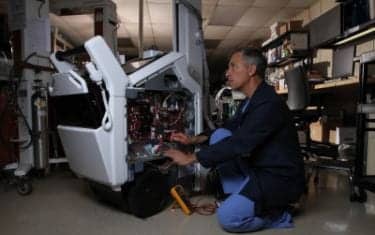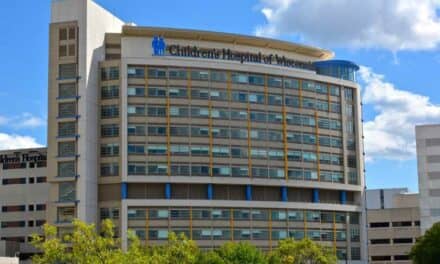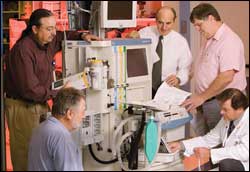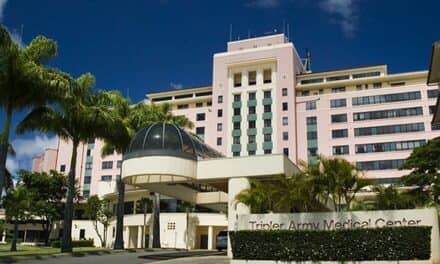A Big Job for the Littlest Patients
The vast Arkansas Children’s health system, based in Little Rock, includes the Arkansas Children’s Foundation, Arkansas Children’s Hospital, Arkansas Children’s Research Institute, and Arkansas Children’s Northwest in Springdale. Tasked with handling the network’s more than 15,000 medical devices and more than 9,500 annual repairs is the healthcare system’s award-winning HTM team.
Below, Boyd M. Hutchins, CTM, healthcare technology manager for the Arkansas Children’s health system, discusses why his team is worthy of AAMI’s “Best Practice Award”—which it won in 2010—and how saving babies is more than just a department credo. It is the HTM team’s overarching goal.
24×7 Magazine: Can you please tell us a little bit about your team and the workload you handle?
Boyd Hutchins: The HTM team supports the Arkansas Children’s system, which includes our 336-bed campus in Little Rock and Arkansas Children’s Northwest—the nation’s newest children’s hospital, located three hours away in Springdale. In addition, we support mobile healthcare clinics and traditional brick-and-mortar clinical locations all over central Arkansas and our Jonesboro Clinic, situated two hours to our Northeast. All told, Arkansas Children’s System’s HTM staff support over 15,000 devices, including imaging, and we complete over 14,000 work requests per year, which include, on average, 365 special projects and 9,500 repairs.
We manage equipment distribution services for our Little Rock hospital campus, as well. This is a “mobile,” sterile processing function, in which portable medical equipment located in soiled utility rooms is cleaned and redistributed to departments to prepare for the next shift. Imaging PACS and cardiology PACS are also a part of our team.
All of our 14 staff report to the Information Services Vice President of Software Applications. We aligned with this reporting structure in 2014, in anticipation of the implementation of new electronic medical records and the proliferation of medical device connectivity. There is one BMET III full-time onsite supporting our Arkansas Children’s Northwest hospital.
24×7: How has your department evolved over the past few years?
Hutchins: Since 2010, when AAMI recognized us as their “Best Practice Award” winner, we have continued to adapt to becoming system-minded, with the addition of new clinic locations and an additional hospital campus. Our ability to operate with Lean methodology keeps us at the leading edge of the requests that come our way. We must do this to make sure we are leading innovation and regulatory compliance, rather than reacting to the challenges we encounter.
24×7: What would your HTM team say are the biggest challenges they face day to day?
Hutchins: The newest challenge we are facing is that of medical device data security. This is a major, ongoing concern for us—and one that we are taking a proactive role in addressing, partly by serving on the IS Data Security Team and by pre-purchase and installation evaluations of a device’s network and data “safety.”
New standards specifically addressing infection prevention as it relates to medical equipment is another challenge, but one that we have been addressing for some time. HTM works very closely with infection preventionists (IPs) in our system to ensure clean medical equipment. This is a major part of our Equipment Distribution program. We also round with the IPs once a week on our environment of care rounds, and one of the inspection points is medical equipment cleanliness.
I asked my technicians what they felt their biggest challenge was, and most of them agreed that medical equipment companies buying other companies all the time makes it difficult to know who to call. Another common comment was the increasing number of medical devices that are being sold as network-able, but, in actuality, fall far short in security, upgrade-ability, and on-network operability.
A company may try to sell us a device and state that it will operate normally with antivirus running in active scan mode—unless it doesn’t. It’s a challenge to install a device and find that it, in fact, does not function on a busy network, and then be forced to decide which security settings are “low-risk” enough to turn off to make it work.
24×7: How does the work your team does every day positively affect the entire hospital?
Hutchins: It is a rare day the HTM department doesn’t have a profound effect on our caregivers’ days. Recently, we’ve been asked to solve problems from equipping a new patient experience-related program called “Commit To Sit” (providing a way for physicians on rounds to sit at the patient’s level during their consultations), to providing proactive patient bed mattress replacements during preventive maintenance.
[We’ve also been tasked with duties ranging from] repairing a patient’s video player while he was waiting for an MRI, to the “normal” heroics of troubleshooting electromagnetic fields interference in a cath lab so services could continue, to working through the approval process for adjusting patient monitor alarm defaults to reduce noise in a care unit.
24×7: What types of medical imaging equipment does your team maintain, and/or how big of a role does maintaining imaging equipment play in your day-to-day workload?
Hutchins: Arkansas Children’s System HTM team manages all imaging modalities with a mix of full-service contracts, PM-only contracts, vendor time and materials, and in-house time and materials. Of course, we do take first call on all systems, solve what we can, and then call the vendor, if needed. While we have the talent and dedication to self-perform more than we do, we balance the need for a quick repair with saving dollars.
A key component of our ability to design this diverse method for service delivery is our Service Delivery Plan program. This program is used to start the discussion with the customer on how each modality will be approached, their uptime expectations, and their approved overtime expenses, should the modality fail.
We feel this kind of agreement also meets the Joint Commission requirement for a written back-up plan for down systems. Imaging work, not including PACS administration duties, averages a little more than a [full-time equivalent], though our imaging technicians also work on general biomed, ICU monitoring, and networking jobs as well.
24×7: Is there anything else you would like to share about your team and what sets them apart from others with 24×7 Magazine’s readers?
Hutchins: Arkansas Children’s System HTM team has operated without a serious employee injury for more than 17 years. Part of our success in this is credited to our outstanding, safety-minded technicians. We also do safety drills whenever an employee injury anywhere in the system is reported. The Arkansas Children’s System also does a wonderful job of being transparent about injuries and other safety events. Such events are never reported and forgotten.
If a safety event is reported, an action is taken to prevent further occurrences. Arkansas Children’s System HTM team operates with less total square footage than 90% of AAMI member hospitals, but provides each technician with more work-space square footage than 90% of those hospitals (as of last published AAMI Benchmarking Data). We truly have a selfless, caring team of biomedical technicians, PACS administrators, and support staff in the Arkansas Children’s System HTM department.
Everybody works or is willing to work on anything. Our imaging technicians can be seen working on medical device connectivity problems; our laboratory specialist works in dialysis and our burn unit; our cardiology and cath lab specialists work on monitoring networks; and our sterilizer specialists’ work also supports our NICU. That’s because, if you ask them what they do, they will tell you: “We save babies.” That is our shorthand for the system’s mission statement: “We are championing children by making them better today and healthier tomorrow.”





